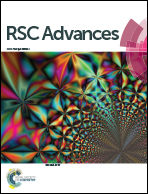Fabrication of a novel BiOI/KTaO3 p–n heterostructure with enhanced photocatalytic performance under visible-light irradiation
Abstract
In this study, a series of BiOI/KTaO3 p–n heterojunctions were prepared via a facile in situ chemical bath strategy. The photocatalytic properties of the catalysts was tested by the degradation of Rhodamine B (RhB) and phenol under visible light irradiation. The BiOI/KTaO3 composites exhibited improved photocatalytic efficiency compared to the individual catalysts. In particular, 54 wt% BiOI/KTaO3 displayed the highest photocatalytic activity since it degraded 98.6% RhB within 30 minutes, while only 68.1% RhB was degraded over pure BiOI under identical conditions. In addition, the reaction kinetic constant of RhB degradation over 54 wt% BiOI/KTaO3 was approximately 2.56 and 115-fold larger than those of pure BiOI and KTaO3, respectively. The results of PL, photocurrent and EIS indicated that the improved photocatalytic efficiency could root in the p–n junction formed between BiOI and KTaO3, which was conducive to the separation and migration of photo-generated carriers. Furthermore, a free-radical capture experiment illustrated that h+ and ˙O2− were the key factors in the photodegradation of RhB.



 Please wait while we load your content...
Please wait while we load your content...